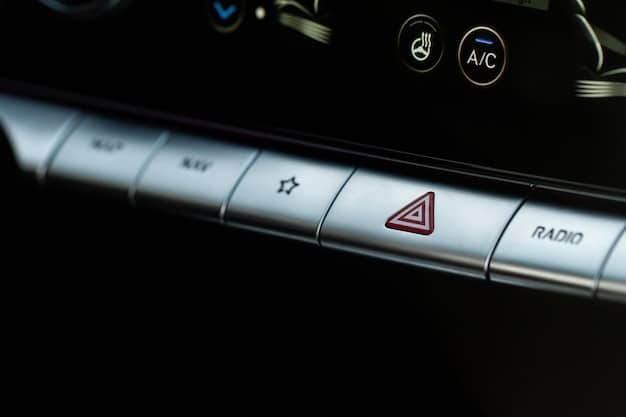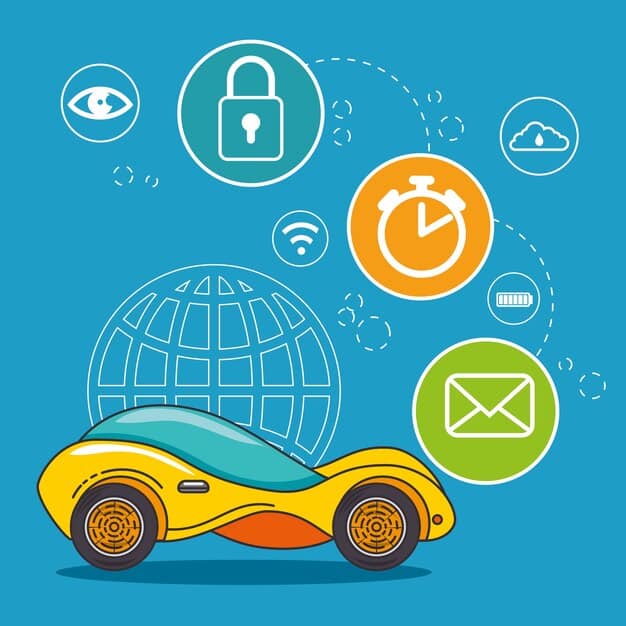Emerging Automotive Cybersecurity Trends & Implications for US Car Owners

Emerging trends in automotive cybersecurity include enhanced intrusion detection systems, AI-powered threat analysis, secure over-the-air updates, blockchain for data integrity, and robust data privacy measures, all critical for protecting US car owners from evolving cyber threats.
The rise of connected and autonomous vehicles has brought unprecedented convenience and capabilities to modern driving. However, this technological leap also introduces significant cybersecurity risks. Let’s delve into what are the emerging trends in automotive cybersecurity and their implications for US car owners, ensuring you’re informed and prepared.
Understanding the Growing Threat Landscape in Automotive Cybersecurity
The automotive industry is undergoing a massive transformation, with vehicles becoming increasingly connected and software-dependent. This connectivity, while offering numerous benefits, also opens doors for cyberattacks. Understanding the evolving threat landscape is crucial for protecting vehicles and their occupants.
The increasing complexity of vehicle systems, coupled with the integration of smartphones and cloud services, creates multiple entry points for malicious actors. From compromised infotainment systems to remote control of critical vehicle functions, the potential consequences of a successful cyberattack can be severe.
Common Cyber Threats Targeting Vehicles
Several types of cyber threats are emerging as significant concerns for the automotive industry. These threats range from relatively simple attacks to highly sophisticated campaigns designed to disrupt or control vehicle systems.
- Malware Infections: Vehicles can be infected with malware through compromised apps, USB drives, or network connections. This malware can then be used to steal data, disrupt vehicle functions, or even gain remote control.
- Remote Hacking: Hackers can exploit vulnerabilities in a vehicle’s software or network systems to gain unauthorized access. This can allow them to remotely control vehicle functions, such as steering, braking, and acceleration.
- Data Theft: Connected vehicles collect vast amounts of data about their drivers, their driving habits, and their destinations. This data can be stolen by hackers and used for identity theft, fraud, or other malicious purposes.
- Denial-of-Service (DoS) Attacks: DoS attacks can disrupt the operation of vehicle systems by flooding them with traffic or overwhelming their resources. This can prevent drivers from accessing critical functions or even render the vehicle inoperable.
Understanding these threats is the first step in mitigating them. Awareness and proactive security measures are essential for protecting connected vehicles from cyberattacks.
In conclusion, the threat landscape in automotive cybersecurity is constantly evolving, requiring continuous vigilance and adaptation. By understanding the potential threats and implementing robust security measures, US car owners can protect themselves and their vehicles from cyberattacks.

Enhanced Intrusion Detection Systems (IDS)
One of the most critical emerging trends in automotive cybersecurity is the development and implementation of advanced Intrusion Detection Systems (IDS). These systems are designed to monitor vehicle networks and systems for signs of malicious activity, providing early warnings of potential cyberattacks.
Traditional security measures, such as firewalls and antivirus software, are often insufficient to protect against the sophisticated cyber threats targeting modern vehicles. IDS provide an additional layer of security by analyzing network traffic, system logs, and other data sources to identify anomalies that may indicate an ongoing attack.
Key Features of Advanced Automotive IDS
Modern automotive IDS incorporate several key features to enhance their effectiveness in detecting and responding to cyber threats.
- Real-time Monitoring: IDS continuously monitor vehicle networks and systems for suspicious activity, providing immediate alerts when a potential threat is detected.
- Behavioral Analysis: IDS use machine learning and artificial intelligence to learn the normal behavior of vehicle systems and identify deviations that may indicate a cyberattack.
- Threat Intelligence Integration: IDS integrate with threat intelligence feeds to stay up-to-date on the latest cyber threats and attack techniques.
- Automated Response: Some IDS can automatically respond to detected threats by isolating compromised systems, blocking malicious traffic, or alerting security personnel.
The implementation of enhanced IDS is crucial for protecting connected vehicles from cyberattacks. By providing early detection and automated response capabilities, these systems can help mitigate the impact of successful attacks and prevent further damage.
In conclusion, enhanced intrusion detection systems are a vital component of modern automotive cybersecurity. Their ability to detect and respond to cyber threats in real-time is essential for protecting connected vehicles and their occupants.
AI-Powered Threat Analysis and Prevention
Artificial intelligence (AI) is playing an increasingly important role in automotive cybersecurity. AI-powered threat analysis and prevention systems can analyze vast amounts of data to identify patterns and anomalies that may indicate a cyberattack, enabling faster and more effective responses.
Traditional security measures often struggle to keep pace with the rapidly evolving threat landscape. AI-powered systems can learn from new threats and adapt their defenses accordingly, providing a more proactive and resilient security posture.
How AI Enhances Automotive Cybersecurity
AI is being used in several key areas to enhance automotive cybersecurity. These applications include:
- Anomaly Detection: AI algorithms can analyze network traffic, system logs, and other data sources to identify unusual patterns that may indicate a cyberattack.
- Threat Prediction: AI can use historical data and threat intelligence to predict future cyberattacks, allowing security teams to proactively implement defenses.
- Automated Incident Response: AI can automate the process of responding to cyberattacks, reducing the time it takes to contain and remediate incidents.
- Vulnerability Assessment: AI can analyze vehicle software and hardware to identify potential vulnerabilities that could be exploited by attackers.
The use of AI in automotive cybersecurity is still in its early stages, but it holds tremendous promise for improving the security of connected vehicles. As AI technology advances, it is likely to become an increasingly essential component of any comprehensive cybersecurity strategy.
In conclusion, AI-powered threat analysis and prevention are transforming the landscape of automotive cybersecurity. By enabling faster, more effective responses to cyber threats, AI is helping to protect connected vehicles and their occupants from harm.
Secure Over-the-Air (OTA) Updates
Over-the-Air (OTA) updates are becoming increasingly common in the automotive industry, allowing manufacturers to remotely update vehicle software and firmware. While OTA updates offer numerous benefits, they also introduce significant cybersecurity risks. Ensuring the security of OTA update processes is crucial for protecting vehicles from cyberattacks.
If an OTA update process is compromised, attackers could potentially inject malicious code into vehicle systems, gaining control of critical functions or stealing sensitive data. Secure OTA updates are essential for maintaining the security and reliability of connected vehicles.
Best Practices for Secure OTA Updates
Several best practices can help ensure the security of OTA update processes:
- Encryption: All OTA updates should be encrypted to prevent attackers from intercepting and modifying the update packages.
- Authentication: Vehicle systems should verify the authenticity of OTA updates before installing them, ensuring that they come from a trusted source.
- Integrity Checks: OTA update packages should include checksums or other integrity checks to ensure that they have not been tampered with during transmission.
- Rollback Mechanisms: Vehicle systems should have the ability to roll back to a previous version of the software if an OTA update fails or introduces new vulnerabilities.
By implementing these best practices, automotive manufacturers can significantly reduce the risk of cyberattacks targeting OTA update processes. Secure OTA updates are essential for maintaining the security and reliability of connected vehicles throughout their lifecycle.
In conclusion, secure over-the-air updates are a critical component of automotive cybersecurity. By implementing strong security measures, manufacturers can protect vehicles from cyberattacks and ensure that OTA updates are delivered safely and reliably.

Blockchain Technology for Data Integrity and Security
Blockchain technology is emerging as a promising solution for enhancing data integrity and security in the automotive industry. Blockchain’s decentralized and immutable nature makes it well-suited for protecting critical vehicle data from tampering and unauthorized access.
In the context of automotive cybersecurity, blockchain can be used to secure vehicle software updates, track vehicle maintenance records, and protect sensor data from manipulation. By ensuring the integrity and authenticity of this data, blockchain can help prevent cyberattacks and improve the overall security of connected vehicles.
Applications of Blockchain in Automotive Cybersecurity
Several potential applications of blockchain in automotive cybersecurity are being explored:
- Secure Software Updates: Blockchain can be used to verify the authenticity and integrity of vehicle software updates, preventing attackers from injecting malicious code.
- Tamper-Proof Maintenance Records: Blockchain can be used to create tamper-proof records of vehicle maintenance, ensuring that critical maintenance procedures are performed correctly.
- Secure Sensor Data: Blockchain can be used to protect sensor data from manipulation, ensuring that autonomous driving systems have access to accurate and reliable information.
While blockchain technology is still relatively new, it holds significant potential for enhancing the security and integrity of connected vehicles. As blockchain technology matures and becomes more widely adopted, it is likely to play an increasingly important role in automotive cybersecurity.
In conclusion, blockchain technology offers a promising approach to enhancing data integrity and security in the automotive industry. By leveraging blockchain’s decentralized and immutable nature, manufacturers can protect critical vehicle data from tampering and unauthorized access.
Strengthening Data Privacy and Regulatory Compliance
Data privacy is a growing concern for US car owners, as connected vehicles collect vast amounts of personal data. Protecting this data from unauthorized access and misuse is essential for maintaining trust and complying with privacy regulations such as the California Consumer Privacy Act (CCPA) and the General Data Protection Regulation (GDPR).
Automotive manufacturers must implement robust data privacy measures to ensure that vehicle data is collected, stored, and used in a responsible and transparent manner. This includes obtaining informed consent from drivers, implementing strong data encryption and access controls, and providing drivers with the ability to access and control their data.
Key Data Privacy Measures for Automotive Manufacturers
Several key data privacy measures can help automotive manufacturers protect vehicle data:
- Informed Consent: Obtain informed consent from drivers before collecting their data, clearly explaining what data is being collected and how it will be used.
- Data Encryption: Encrypt all vehicle data both in transit and at rest to protect it from unauthorized access.
- Access Controls: Implement strong access controls to limit access to vehicle data to authorized personnel only.
- Data Minimization: Collect only the data that is necessary for the intended purpose, minimizing the amount of personal data stored on vehicle systems.
By implementing these data privacy measures, automotive manufacturers can demonstrate their commitment to protecting the privacy of US car owners and complying with relevant privacy regulations.
In conclusion, strengthening data privacy and regulatory compliance is a critical aspect of automotive cybersecurity. By implementing robust data privacy measures, manufacturers can protect vehicle data from unauthorized access and misuse, maintaining trust and complying with privacy regulations.
| Key Aspect | Brief Description |
|---|---|
| 🛡️ Enhanced IDS | Real-time threat detection and automated response. |
| 🤖 AI Threat Analysis | AI predicts and mitigates potential cyber-attacks. |
| 📡 Secure OTA Updates | Safeguarding remote software updates. |
| 🔒 Blockchain Security | Immutable record-keeping for data integrity. |
Frequently Asked Questions (FAQ)
▼
Modern cars face threats like malware infections, remote hacking, data theft, and denial-of-service (DoS) attacks. These can compromise vehicle functions and personal data.
▼
Enhanced IDS monitor vehicle networks for suspicious activity, using real-time monitoring and behavioral analysis to detect and respond to potential cyber threats.
▼
AI enhances cybersecurity through anomaly detection, threat prediction, automated incident response, and vulnerability assessment, enabling faster and more effective protection.
▼
Secure OTA updates ensure that vehicle software is updated safely and reliably, preventing attackers from injecting malicious code into vehicle systems during the update process.
▼
Blockchain provides a decentralized and immutable ledger for verifying software updates, tracking maintenance records, and securing sensor data, enhancing data integrity.
Conclusion
As vehicles become increasingly connected, automotive cybersecurity is more important than ever. By understanding the emerging trends in this field and taking proactive security measures, US car owners can protect themselves and their vehicles from the growing threat of cyberattacks.





